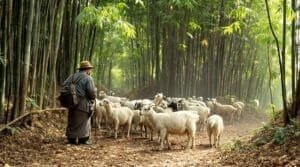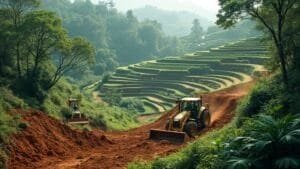Human settlements near forests are increasingly putting red panda populations at risk through a combination of environmental disruption and direct threats. As people expand into forest edges for farming, grazing, or development, red pandas lose the continuous bamboo-rich habitats they need to survive. Roads, fires, and livestock alter the landscape, while domestic dogs introduce new dangers through disease and predation
These changes not only fragment red panda habitats but also make them more vulnerable to poaching and human conflict. In this article, we explore how human settlements near forests threaten red panda populations by examining issues such as habitat degradation, disease transmission, and poaching risks—while also highlighting the conservation measures that can help mitigate these impacts
Human Settlement Impacts on Red Panda Habitats

Red pandas rely on cool, temperate forests filled with dense bamboo undergrowth, which they use for feeding, nesting, and shelter. These forests, spread across the eastern Himalayas and southwestern China, are under increasing pressure from expanding human settlements
As villages grow along forest edges, they directly encroach upon red panda habitats, leading to deforestation, land degradation, and a sharp increase in human-wildlife conflict. The proximity of human activity to red panda ranges has emerged as a major conservation challenge, especially in countries like Nepal and India, where much of the red panda’s remaining habitat lies outside protected areas
Deforestation and Habitat Fragmentation from Village Expansion
The expansion of rural communities often requires clearing forests for housing, crop cultivation, and the construction of roads and other infrastructure. This development reduces the amount of contiguous forest available for red pandas and breaks up their habitat into isolated patches. These fragmented landscapes disrupt red panda movement, reduce access to food, and limit opportunities to find mates, which can lead to inbreeding and genetic bottlenecks
According to the Red Panda Network, over 70% of red panda habitats in Nepal are located outside national parks and reserves. These areas are frequently used by communities for fuelwood collection and agriculture. As forests are cleared or degraded, red pandas are forced into smaller territories, which can lead to increased competition for resources and reduced survival rates
Fragmentation also increases the “edge effect,” where the boundaries between human-dominated landscapes and natural ecosystems become hotspots for ecological instability. These edge zones expose red pandas to human-related threats such as livestock, dogs, fires, and even hunting
A 2020 study by Thapa et al., published in Global Ecology and Conservation, confirmed that red pandas prefer core forest areas far from human disturbance and are rarely found near roads or cleared areas
Livestock Grazing and Bamboo Depletion
In many forest-adjacent communities, livestock grazing is a major component of rural livelihoods. However, uncontrolled grazing severely impacts red panda habitats, especially by trampling and consuming bamboo—their primary dietary staple. Overgrazed areas cannot regenerate quickly enough to support red panda populations, leading to food scarcity and habitat abandonment
A study conducted in Langtang National Park, Nepal, and published in PeerJ (2021), revealed that livestock grazing had significantly degraded over 60% of key red panda habitats. The loss of bamboo in these areas not only limits food availability but also increases the red pandas’ vulnerability as they are forced to roam longer distances in search of sustenance
Grazing also involves the felling of trees for shelter or fuel, further disrupting the nesting behavior of red pandas. They prefer tree hollows and dense vegetation for resting and raising cubs, and the loss of such microhabitats directly affects their reproductive success
Fire and Land-Clearing Practices in Forested Areas
Another major threat posed by human settlements is the use of fire for land-clearing. Slash-and-burn agriculture, a traditional but ecologically damaging method, is still widely practiced in parts of Nepal, India, and Myanmar. While intended to convert forest land into farmland, these fires often spread uncontrollably into surrounding forests, destroying critical red panda habitats
Human-caused forest fires not only eliminate bamboo groves and nesting trees but also leave behind degraded, fragmented landscapes that are slow to regenerate. According to data cited by the Red Panda Network, unregulated burning in areas like Lamjung and Ilam districts has destroyed large portions of potential red panda habitat
The aftermath of forest fires can be long-lasting. Soil fertility is often reduced, bamboo regrowth slows, and forest structure becomes unsuitable for red pandas. The use of fire also correlates with increased human activity in sensitive zones, compounding the impacts of habitat loss
For a broader overview of how red panda habitats are impacted by human development, the IFAW article on red panda threats and fragmentation provides valuable insights into how roads, settlements, and forest clearing reshape panda ranges
Direct Threats to Red Panda Health and Safety

Beyond habitat degradation, red pandas face numerous direct threats when human settlements encroach upon forested areas. These include attacks by free-roaming domestic animals, exposure to infectious diseases, and increased vulnerability to poaching. Unlike large predators that can often evade human contact, red pandas are small, slow-moving, and solitary—traits that make them particularly susceptible to anthropogenic threats when living near rural villages
Attacks and Disease Transmission from Free-Roaming Dogs
Free-roaming domestic dogs, commonly associated with rural settlements and herding communities, are one of the most immediate threats to red panda survival. These dogs often roam unsupervised into forested areas, where they may chase, injure, or kill red pandas. In addition to physical attacks, they also pose a significant risk as disease vectors
Canine distemper virus (CDV), rabies, and other diseases carried by domestic dogs are highly infectious and frequently fatal to red pandas. According to the Red Panda Network, canine distemper outbreaks have led to population declines in several red panda habitats. A report published by Ale et al. (2020) found that free-roaming dogs were the primary suspects in a series of red panda deaths in eastern Nepal, where several carcasses were found with signs of trauma or infection
This threat is intensified by the growing overlap of human and red panda habitats, particularly in areas where livestock herding occurs close to forest edges. Vaccination programs and dog population control measures have been implemented in some regions, but enforcement and coverage remain inconsistent across the red panda’s range
Increased Poaching and Illegal Wildlife Trade Risks
Human settlements near forests often facilitate access for poachers. As roads are built and trails are cleared for villagers, these same paths become routes for illegal hunters and traders. Red pandas are poached for their distinctive red fur, which is sometimes used in ceremonial clothing or sold on the black market. They are also occasionally captured alive for the illegal pet trade in parts of Asia
The proximity of red panda habitats to villages makes poaching easier and more efficient. According to WWF, 121 red panda skins were confiscated in Nepal alone between 2008 and 2018. These incidents typically occur near forest peripheries where monitoring is difficult and law enforcement is weak. Traps set for other animals, such as musk deer or wild boars, also inadvertently catch red pandas, resulting in unintentional but deadly consequences
The Red Panda Network has developed anti-poaching patrols and community monitoring programs that aim to curb these activities. Their Forest Guardians initiative trains local residents to track poaching activity, dismantle traps, and report illegal actions. These community-led interventions have shown promise, but poaching continues to be a persistent threat in areas with high human traffic and low awareness
Disease Risks from Domestic Animals
Aside from direct attacks, domestic animals living near forests can also transmit a range of diseases to red pandas through shared water sources, contaminated food, or direct contact. Infections such as toxoplasmosis and parasitic infestations have been documented in wild populations exposed to livestock or pets
Veterinary studies in Nepal and India have detected zoonotic pathogens in red pandas living near pastoral communities, indicating cross-species transmission. One of the major concerns is that these diseases often go undetected until they result in visible population declines or death. The lack of routine health monitoring for red pandas and poor vaccination rates among rural dogs exacerbate this risk
Moreover, red pandas may come into contact with human waste or discarded food in areas where forest boundaries are poorly maintained. This contact increases exposure to pathogens and disrupts natural feeding behaviors, potentially weakening their immune systems over time
A deeper look at these zoonotic threats can be found in this Red Panda Network resource on disease transmission, which also outlines community-based health interventions aimed at protecting both domestic animals and wildlife
Human Activity and Behavioral Disruption

Even when red pandas aren’t physically harmed by human settlements, the proximity of human activity to their habitats can significantly disrupt their natural behavior and reduce their ability to survive and reproduce. From tourism infrastructure to changing landscape patterns, red pandas face constant disturbances that alter how they move, eat, and interact with their environment. These indirect effects, while harder to quantify than poaching or habitat loss, are deeply influential in shaping red panda population dynamics
Tourism and Infrastructure Effects on Red Panda Behavior
Eco-tourism and road construction—though economically beneficial for local communities—can have severe ecological consequences when not managed properly. The development of lodges, viewing trails, and transportation access roads into red panda habitats increases human traffic and noise, often driving these shy animals away from suitable areas
Red pandas are highly sensitive to disturbance. A study published in Global Ecology and Conservation (2018) found that red pandas tend to avoid areas with active human presence, even if those areas offer ideal foraging conditions. This avoidance behavior reduces the effective size of their habitat, concentrating individuals into smaller, suboptimal zones, which in turn increases competition and stress
Additionally, the creation of hiking trails and access points often brings litter, pollution, and stray animals deeper into forest areas. Tourists may unknowingly disrupt red panda feeding grounds or nesting sites, especially during the breeding season when mothers with cubs are particularly vulnerable to disturbance
Infrastructure can also serve as a physical barrier to movement. Red pandas rarely cross open areas or roads, and the fragmentation caused by construction divides populations and impedes gene flow. In heavily visited parks like Singalila and Langtang, red pandas have been observed shifting their activity patterns, becoming more nocturnal to avoid daytime disturbances—an adaptation that can interfere with feeding and thermoregulation
Community-Driven Conservation Solutions
Recognizing the threats posed by settlement expansion and human proximity, numerous conservation programs now focus on engaging local communities as partners in red panda protection. These initiatives include education campaigns, alternative livelihood development, participatory monitoring, and habitat restoration efforts
The Red Panda Network’s Forest Guardian program exemplifies this approach. Locally hired and trained individuals patrol forests, dismantle traps, monitor red panda movements, and collect ecological data. These guardians serve as the eyes and ears of the forest, often preventing habitat degradation before it escalates
Another promising approach is sustainable eco-tourism. In Nepal’s Ilam and Taplejung districts, community-managed lodges and guided tours are designed to minimize ecological footprints while providing income to local families. These projects include visitor education about red panda behavior and habitat needs, helping reduce inadvertent human impact
Reforestation is also a major component of mitigation. In areas where deforestation has occurred, local groups—often with NGO support—plant native trees and bamboo to restore degraded zones and reconnect fragmented habitats. These efforts not only benefit red pandas but also enhance biodiversity and ecosystem resilience overall
A comprehensive overview of these community-based efforts and policy recommendations can be found in the IFAW’s red panda conservation strategy, which emphasizes the role of responsible development in reducing threats from nearby human populations












